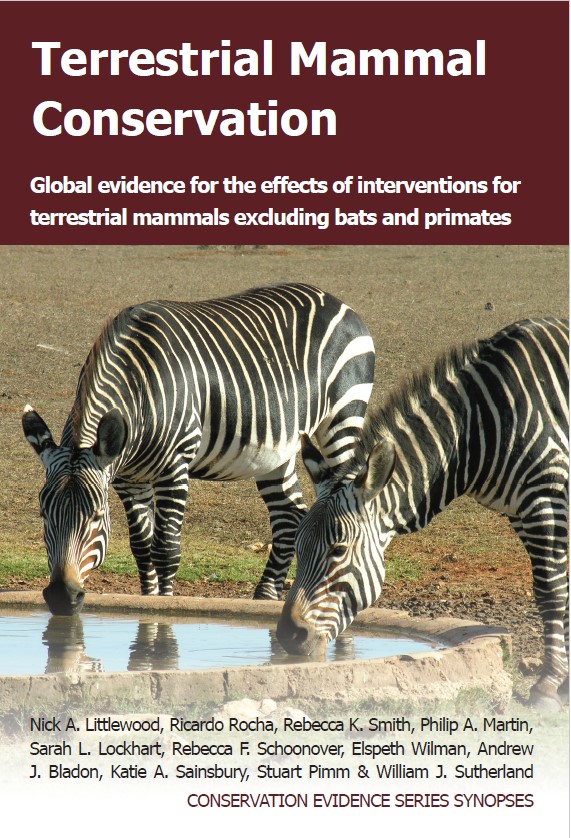Actions to conserve biodiversity
We have summarised evidence from the scientific literature about the effects of actions to conserve wildlife and ecosystems.
Review the evidence from the studies
Not sure what Actions are? Read a brief description.
Search for evidence
e.g. "frogs chytrid"
294 Actions found
Refine
Hide
294 Actions found
Download Actions
| 0 selected |
|
Order results by:
| Action | Effectiveness | Studies | Category | |
|---|---|---|---|---|
|
Use non-lethal methods to deter carnivores from attacking humans Action Link |
Likely to be beneficial | 8 |
|
|
|
Install non-electric fencing to exclude predators or herbivores and reduce human-wildlife conflict Action Link |
Beneficial | 8 |
|
|
|
Provide artificial refuges/breeding sites Action Link |
Likely to be beneficial | 8 |
|
|
|
Use selective harvesting instead of clearcutting Action Link |
Likely to be beneficial | 8 |
|
|
|
Create uncultivated margins around intensive arable or pasture fields Action Link |
Beneficial | 9 |
|
|
|
Exclude livestock from semi-natural habitat (including woodland) Action Link |
Likely to be beneficial | 9 |
|
|
|
Use taste-aversion to reduce predation of livestock by mammals to deter human-wildlife conflict Action Link |
Likely to be beneficial | 9 |
|
|
|
Scare or otherwise deter mammals from human-occupied areas to reduce human-wildlife conflict Action Link |
Likely to be beneficial | 10 |
|
|
|
Use loud noises to deter crop damage (e.g. banger sticks, drums, tins, iron sheets) by mammals to reduce human-wildlife conflict Action Link |
Likely to be beneficial | 10 |
|
|
|
Use fencing to exclude predators or other problematic species Action Link |
Likely to be beneficial | 10 |
|
|
|
Install rope bridges between canopies Action Link |
Beneficial | 10 |
|
|
|
Remove or control predators Action Link |
Trade-off between benefit and harms | 10 |
|
|
|
Translocate problem mammals away from residential areas (e.g. habituated bears) to reduce human-wildlife conflict Action Link |
Likely to be ineffective or harmful | 11 |
|
|
|
Translocate predators away from livestock to reduce human-wildlife conflict Action Link |
Trade-off between benefit and harms | 11 |
|
|
|
Install electric fencing to reduce predation of livestock by mammals to reduce human-wildlife conflict Action Link |
Beneficial | 11 |
|
|
|
Install electric fencing to protect crops from mammals to reduce human-wildlife conflict Action Link |
Beneficial | 11 |
|
|
|
Restore former mining sites Action Link |
Likely to be beneficial | 12 |
|
|
|
Thin trees within forest Action Link |
Likely to be beneficial | 12 |
|
|
|
Use guardian animals (e.g. dogs, llamas, donkeys) bonded to livestock to deter predators to reduce human-wildlife conflict Action Link |
Beneficial | 12 |
|
|
|
Use repellents that taste bad (‘contact repellents’) to deter crop or property damage by mammals to reduce human-wildlife conflict Action Link |
Likely to be beneficial | 12 |
|
|
|
Install barrier fencing along roads Action Link |
Beneficial | 12 |
|
|
|
Rehabilitate injured, sick or weak mammals Action Link |
Likely to be beneficial | 13 |
|
|
|
Reduce intensity of grazing by domestic livestock Action Link |
Beneficial | 13 |
|
|
|
Release captive-bred mammals into fenced areas Action Link |
Beneficial | 14 |
|
|
|
Hold translocated mammals in captivity before release Action Link |
Likely to be beneficial | 15 |
|
Download Actions
| 0 selected |
|

Terrestrial Mammal Conservation - Published 2020
Terrestrial Mammal Conservation
Watch this search
If you are familiar with RSS feeds, please click the button below to retrieve the feed URL:
RSS feed for this searchIf you are unfamiliar with RSS feeds, we would suggest reading this BBC article.
Unfortunately, due to the number of feeds we have available, we cannot provide e-mail updates. However, you could use tools such as Feed My Inbox to do this for you.
What are 'Individual studies' and 'Actions'?
Individual studies
An individual study is a summary of a specific scientific study, usually taken from a scientific journal, but also from other resources such as reports. It tells you the background context, the action(s) taken and their consequences.
If you want more detail please look at the original reference.
Actions
Each action page focuses on a particular action you could take to benefit wildlife or ecosystems.
It contains brief (150-200 word) descriptions of relevant studies (context, action(s) taken and their consequences) and one or more key messages.
Key messages show the extent and main conclusions of the available evidence. Using links within key messages, you can look at the paragraphs describing each study to get more detail. Each paragraph allows you to assess the quality of the evidence and how relevant it is to your situation.
Where we found no evidence, we have been unable to assess whether or not an intervention is effective or has any harmful impacts.





)_2023.JPG)














